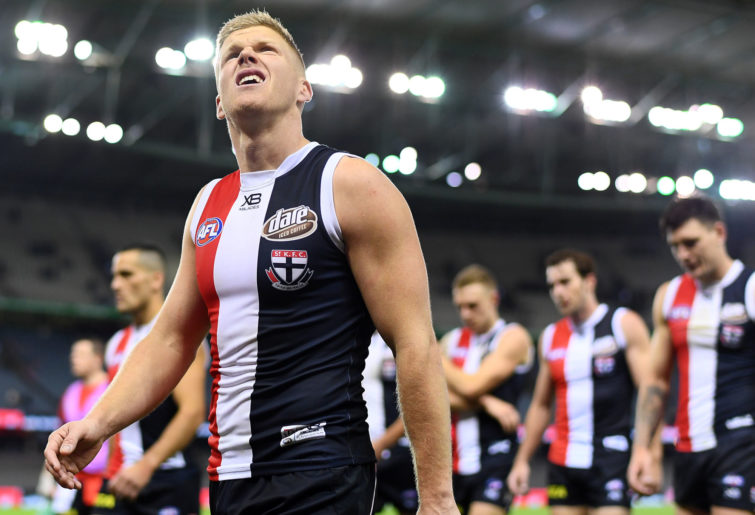St Kilda have a reasonably well-balanced list, with a youth contingent that is on par with the average AFL standard, and a prime-age group that is actually a little more beefed-up and this year produced just a tick over the average games and AFLCA votes.
Where they are lacking is in the veteran category. Nathan Brown was the only one to play any significant number of games from the Saints’ 28-and-over brigade this year, with persistent injury problems for Jarryn Geary a notable factor here.
David Armitage and Sam Rowe have finished up their time at the club, but Dan Hannebery, Jake Carlisle and Jack Steven (the latter two assuming they remain at the club) will all graduate into St Kilda’s veteran bracket next year.
Veterans aside, the Saints have a decent spread of vote-getters across their list – they’re not dependent a single player, but they also don’t have any real standout talent. Sixteen other clubs had at least one player collect more AFLCA votes than St Kilda’s best, with Gold Coast the only team unable to top them.
| St Kilda Saints list profile |
| Age |
Players |
Games |
% of total |
Votes |
% of total |
| 18-22 |
21 |
162 |
35.06% |
58 |
21.72% |
| 23-27 |
22 |
272 |
58.87% |
195 |
73.03% |
| 28+ |
5 |
28 |
6.06% |
14 |
5.24% |
Under or over?
St Kilda fielded the second-least experienced side in the AFL this year, and the third-youngest on average – they were less than two games better experienced than Gold Coast on average, and in the middle of sides like Sydney and the Western Bulldogs for average age.
The Saints would probably have preferred to field a more experienced side each week, but didn’t have the capacity to, given regular injuries to key players. Their EUR for the season was 55.1 per cent, better only than Sydney, and more than 12 points below the league average.
The Saints entered only two matches all year being more experienced than their opponents, both times against the Gold Coast Suns, and won both. They were able to win about 36 per cent of the time when fielding a less-experienced side than their opponents, which is on par with the league average.
Verdict: Overperformed. To be hit as hard by injury as they were and field one of the youngest and most inexperienced side in the competition all year but still put nine wins on the board and finish with a respectable percentage of 83 is a pretty impressive effort, under the circumstances.
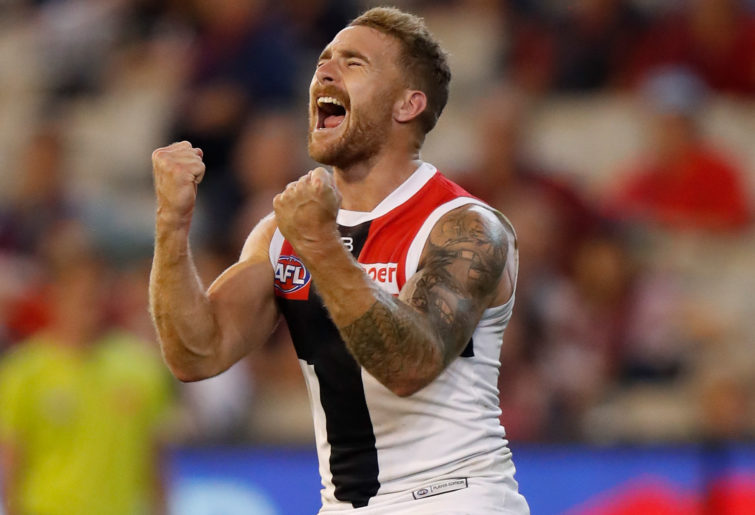
(Photo by Michael Willson/AFL Photos/Getty Images)
Contract watch
Out of contract
Nathan Brown, Doulton Langlands, Jack Mayo, Jack Newnes, Bailey Rice, Brandon White.
Pre-agents
Jack Steven.
Nathan Brown was told at his exit meeting that the Saints can’t guarantee him a contract for 2020 yet, which for mine seems like a really poor decision given that he was essentially St Kilda’s only veteran player to make any real impact in the season just gone.
Even if he is not a best 22 player next year then he’s a good solid option to have at VFL level for depth if needed, especially given the uncertainty around whether Carlisle will be at the club or, if he is, whether he’ll be available to play.
Jack Newnes is a more difficult proposition. Something of a living metaphor for St Kilda’s rebuild, he seemed on the verge of becoming a real standout player in the side before radically dropping off over the last two years and struggling to have an impact.
St Kilda would probably be happy for him to seek a change in fortunes at a new club, especially given he’s a free agent and they could get a compensation pick maybe in the third or at best end-of-second round, but it doesn’t appear as if any other teams are seriously interested at this stage.
Jack Steven is a pre-agent to watch this year with reports that he is a strong chance to be traded to Geelong. We’ll discuss that more soon.
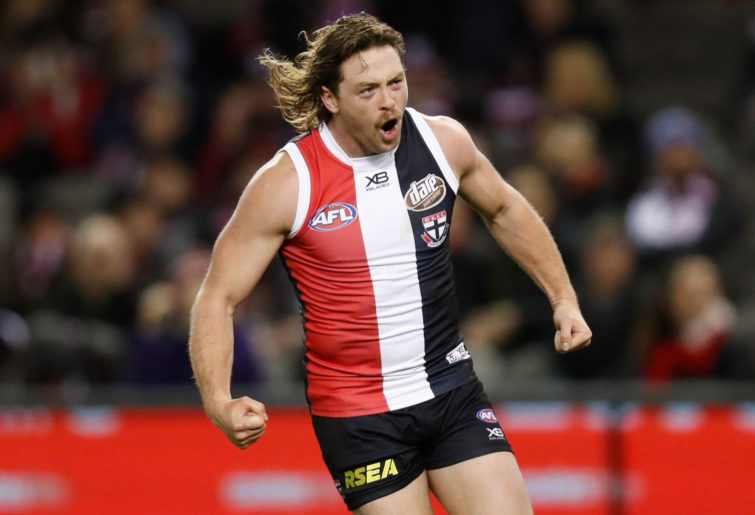
(Photo by Michael Willson/AFL Photos via Getty Images)
Free agency
Brown and Newnes are both free agents at the Saints this year – the same was true of David Armitage, Lewis Pierce and Sam Rowe, who have all retired/been delisted and appear unlikely to be in the AFL in 2020.
The Saints are low on draft options this year – while they’ve finished with pick 5 in hand, they’ve already traded out their second and third-round picks in this year’s draft in the 2018 trade period, meaning they don’t pick again till 55.
That will make them all the more keen on hopefully getting some kind of pick in return of Newnes leaving the club, if he does, but also makes free agency an attractive option via which to pursue players as they wouldn’t need to give up any currency for them (though bringing in a free agent would cancel out any Newnes compensation).
What do they need? Rather than being after a specific player type, I’d argue St Kilda’s biggest need is simply A-grade talent, wherever the fits on the ground. They have also identified the need to bring in a ruck, which is probably true after delisting both Billy Longer and Lewis Pierce.
Stephen Coniglio is one they were known to have pursued with a big-money offer only for him to re-sign with GWS on a long term deal during the week. Even if he did decide to return to Victoria, it’s understood they were probably well behind Hawthorn and Carlton in the race for his services.
Unfortunately Coniglio was probably the only genuine A-grader available on the free agency market this year, and the players they would be looking at now are more bits-and-pieces types who could potentially play a role for the team if they’re the right fit.
Todd Goldstein is one they have been linked to as a ruckman, while Sam Jacobs and Tom Nicholls are also available. All the latest news is linking them to instead bringing Paddy Ryder across from Port Adelaide, which makes it seem unlikely they’ll sign any of those three.
Adam Tomlinson is also one they’ve been known to have an interest in in the past, and his future remains very much unclear at this stage. With some doubts existing over both Carlisle and Brown at the club, he could be a good fit.
Trade period
St Kilda look like being perhaps the busiest club in this year’s trade period. They could see as many as four players leave the club, while it would almost be a shorter exercise to list the players they haven’t been linked to, rather than those they have.
Let’s start with the more exciting angle, and talk players coming in. The big name here who looks a virtual certainty to be in red white and black come 2020 is Brad Hill, who has officially requested a trade out of Fremantle.

(Photo by Daniel Carson/AFL Media/Getty Images)
Hill is contracted for the next two years at the Dockers and Fremantle will play hardball on trading him, but the Saints appear to be in pole position to get the deal done for two reasons – a) they’re offering Hill more cash than any other club is, and b) they’ve got a high pick with which to talk Fremantle to the table.
Is Hill worth pick 5 in the draft? There’s arguments for and against. On one hand, he’s undoubtedly an elite player with some rare traits, and it’s a weaker draft than most. On the other hand, at 26 years old, he’s played a decent chunk of his best footy already.
Simply put – if you want the best total return, the draft is pretty much always a better investment than paying a high price for a mature player. But, trades will have a quicker impact – so it boils down to whether or not you think that impact will a poorer return overall worth your while.
Does that make this the right move for the Saints? Well, that’s something for us to discuss a bit later on.
In terms of players likely to land at the club, the other notable ones are Zak Jones and Paddy Ryder. They both potentially bring something valuable to the team, but are of debatable worth.
Jones has become something of a whipping boy for Sydney fans – he probably played his best season of football this year averaging 22 touches and nearly four tackles, but never really got a lot of positive press outside the trade rumour talk despite that.
I like Jones – he’s tough, but he’s also got a decent burst of speed, which you don’t always see in players like him. He needs to learn to use that better, and he needs to improve his kicking. Although I’m not a big fan of the stat, it’s worth noting his 71 per cent disposal efficiency this year was a career-worst.

(AAP Image/Julian Smith)
For mine with Jones it comes down to what you have to pay for him. If the Saints can get him for a reasonable price then it’s worth a roll of the dice, because he could be a really valuable player if he learns how to play to his strengths and mitigate his weaknesses.
The issue for the Saints is they’ve already traded out most of their picks this year and really need to avoid doing that for next year’s draft as well, as they’ve done for several consecutive years. I’d be looking at what they can get in from other clubs for outgoing players, and trying to get a deal done using that.
Given Jones is out of contract and doesn’t have many if any other clubs in the race for him, that shouldn’t be too hard to organise.
The Saints also appear in the box seat to land Paddy Ryder – he has also been linked to a return home to Essendon, but St Kilda appears the more likely destination at this stage.
Personally, I find this one a little confusing – the Saints uncovered a really good ruckman in Rowan Marshall this year, but seem intent on having him play the majority of his time forward and instead finding another ruckman that he can occasionally pinch-hit for.
Marshall was arguably their best player this year and should be on the podium in the best and fairest, so personally I don’t feel like there’s any good reason to move him out of a position where he’s already proven he can play quality football. Instead, at 23, he should be a set-and-forget first ruck picked at the club for the next five-ten years.
Surely the Saints’ selection committee remember how frustrating it was to have two players in Billy Longer and Tom Hickey who both played better as the No.1 ruck, struggling to decide between them and ultimately having a lack of continuity in the middle because of that? Let’s not do that again.
Instead if I were the Saints I’d be looking simply at getting in a mature ruckman who knows they are coming to the club mostly as a depth option, like a Tom Nicholls, Jon Ceglar or Zac Smith, and allowing Marshall to play where he plays best.
Still, Ryder seems likely. Like Jones, the Saints should resist the urge to dip into next year’s picks for him. He probably only has two years left in the game, and a selection in the fourth round should be enough to get the deal done.
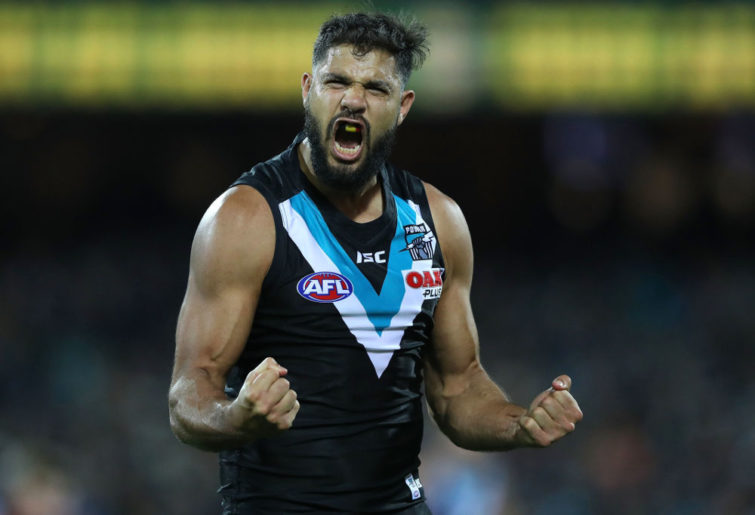
(Photo by Robert Cianflone/Getty Images)
Over the course of the season, St Kilda have also been linked to: Brad Crouch, Hugh Greenwood, Ed Langdon, Charlie Constable, Ben King, Jack Martin and Karl Amon. It’s not clear the moment whether they’re a serious chance to get any of them or, if they do, how on earth they’d look to pay for them given their lack of draft currency.
Probably all of these players bar Greenwood and Constable – who I’d argue are too simillar to some of the midfielders already at the club – could be worthy recruits at the Saints. And who knows, one or two of them just might happen. Trade period is unpredictable. Right now, it’s probably too early to discuss potential deals.
Jack Steven headlines the players likely to leave the club. He has played 183 games for St Kilda and won four best-and-fairests, but seems likely to be at Geelong next year after requesting and being denied a trade there at the end of 2018, only to miss much of the season battling difficulties with his mental health.
It looks like all parties concerned believe a fresh start would be the best thing for Steven and possess the good will required to make that happen. While he’s now unlikely to draw the kind of value he might have a year ago, he is probably St Kilda’s best chance to finagle the draft currency needed to land Zak Jones.
Also potentially on the outer is Josh Bruce, who has drawn interest from the Western Bulldogs. If the Saints want to play Marshall forward and are also expecting Max King to be a regular in the side next year then it’s probably not a bad time to move Bruce on.
He’s by no means elite for his position but is reasonably good at playing that ruck-forward role, and you can see why he would appeal to the Dogs as someone who can be a third tall behind Aaron Naughton and Josh Schache while also providing a chop-out in the ruck for Tim English.
Both are contracted for next year so the Saints have a reasonable case to ask for a second-round picks in exchange for their departures – on current ladder positions, that would be picks 30 and 36, one of which could go to the Swans for Jones, and the other be kept for their own use.
Jake Carlisle is someone who has also been thrown up in trade discussions, but this one is a bit hard to get a read on. He recently passed a trigger for another year at the club in 2020 at about $600,000 and has reportedly been a big part of the Saints’ approach to Paddy Ryder, being a former teammate.
At the same time, there’s a little rumour around that if another club was willing to take him on board, both Carlisle and the Saints would be content to part ways. No one has been linked to him just yet but you’d think Collingwood and maybe also Hawthorn should both take a serious look.
The Saints could consider sweetening a deal by agreeing to pay a decent chunk of Carlisle’s salary within their own cap next year – they certainly have the money spare. An offer like that might be enough to shake a second-round pick free from the Hawks or Pies (currently holding picks 28 and 33 respectively).

(Photo by Scott Barbour/Getty Images)
Lastly, Blake Acres is a chance to move to Fremantle as part of the deal to get Brad Hill to the Saints. He’s not worth a whole lot on his own, and his inclusion seems unlikely to convince the Dockers to take something lower than pick 5 alongside him – not that St Kilda currently have anything to offer there anyway.
Draft
Picks inside 30: 5.
Pick 5 is, as mentioned, most likely to belong to a rival club come November, and the question here is, if that’s the case, how do St Kilda make any draft investment of note this offseason?
One potential strategy is to pursue a deal which would see them trade pick 5 to the GWS Giants for the two picks they currently hold in the early teens – send one of these along with Acres to Fremantle, and keep one for this draft.
It’s a nice idea, and arguably not too far off Hill’s ‘real’ worth, but there’s a few reasons I expect it won’t come to fruition.
The biggest roadblock is that St Kilda are not the only team willing to make this trade – both Melbourne and Adelaide are known to be interested in a similar deal, and they both have higher picks available to offer the Giants than St Kilda do.
The most likely scenario I expect is that a Gold Coast priority pick bumps Melbourne and Adelaide down to picks 3 and 4, and I expect at least one of those clubs to hold GWS to ransom – ‘either trade with me, or I’ll bid on Tom Green.’ That would make a deal with St Kilda pretty much useless to the Giants.
Brisbane with picks 15 and 19 are the only other club to have multiple selections in the teens, and so would probably be St Kilda’s best bet of making a deal like this.
5 for 15, 19 and 35 might be something that works for both clubs – potentially allowing St Kilda to land Hill and still have some reasonable picks, while Brisbane get access to a higher grade of talent than a club finishing so high up the ladder usually would.
Here is where we run into the other problem with this scenario though, which is that Fremantle are probably going to be significantly less interested in getting a deal done with St Kilda if it is pick 15 on offer rather than pick 5, and may push Hill towards a club with a better offer, or hold him to his contract. If getting Hill is St Kilda’s top priority, don’t expect them to go down this path.
Hypothetically let’s say the Hill deal falls through and the Saints take pick 5 to the draft – who would they be likely to consider picking?
Probably something that’s driving their desire to seek out a mature player this year is that there isn’t necessarily a stand-out option who appears an especially good list for their list.
As I’ve said, they probably need top-tier talent in any position rather than to target a specific player type, and there simply may not be any in this draft beyond the first two picks.
Lachie Ash is someone who would add a bit of speed to their list and probably be a good replacement for Dylan Roberton if, as seems likely, his heart issues force him into early retirement.
Someone like Brodie Kemp might be the highest-potential player at their pick, but he has done his ACL and after drafting Max King last year that’s a risk they might not be keen to take.
Fisher McAsey might be the best fit in terms of player type as a key defender, given they haven’t gotten a huge number of games yet into the young tall backs on their list. Sam Flanders and Dylan Stephens are others who could be considered.
What I said last year
“An unexpectedly poor result in 2018 has seen St Kilda become impatient in the extreme – they’ve sacked their list manager, brought in a new one, and are making calls to anyone who might be interested in coming to the club.
“But the scattergun strategy is only going to be ineffective and drive them madder still. It’s the answer no one wants to hear, but the path to genuine success is to keep the focus on drafting elite young talent and developing it as best they can.
“This has to be priority number one, and any decision that takes away from their ability to achieve this goal is a poor decision to make…
“They may feel impatient, and they may worry that their fans will feel frustrated and the club will lose support – but this is a poor rationale to make decisions based upon.
“The St Kilda supporters I know are loyal and sensible people. They’re realistic about where the club is at and would rather see prudent investment in the draft than a frantic free agency frenzy.
“St Kilda have a fair distance to go in their rebuild and they do need to tinker with their approach a little, but if they keep their heads they’ll find they’re not too far off course.”
Outlook
The Saints managed to avoid my worst fear for them last year – that they would downgrade their pick 4 in the draft to get Dan Hannebery – and overall put in a solid performance on the list management front, despite again trading away future selections.
However they don’t appear to have become any less impatient 12 months on – they sacked their senior coach this year despite relatively admirable performances on field, and have been linked with twice as many on-the-market opposition players as any other club in the league.
This is a team that after coming heartbreakingly close to a premiership in 2009 and 2010 has now missed finals for eight consecutive years, sacking two senior coaches in that time. You can understand why they would be impatient, but that mood shouldn’t influence their decision-making process.
When their decline began in 2011 they didn’t start rebuilding soon enough, and they didn’t stick with it as long as they needed to.
In 2012 they had two first-rounders thanks to the departure of Brendon Goddard but traded the picks away for Tom Hickey and Tom Lee. You’ll read that and ask ‘who on earth is Tom Lee?’, and that’s exactly the problem.
While they did make an admirable investment in the draft over the 2013-14 period, whether by poor choice or bad luck the players acquired there have not proved to be the solid foundation they hoped they would be. They then pivoted too early into making a big trade for Jake Carlisle in 2015.
As an individual deal the Carlisle trade has arguably been a winner for them – they found a star in Jade Gresham with the pick they downgraded too, while Aaron Francis, taken at the pick they gave up, hasn’t set the world on fire just yet.
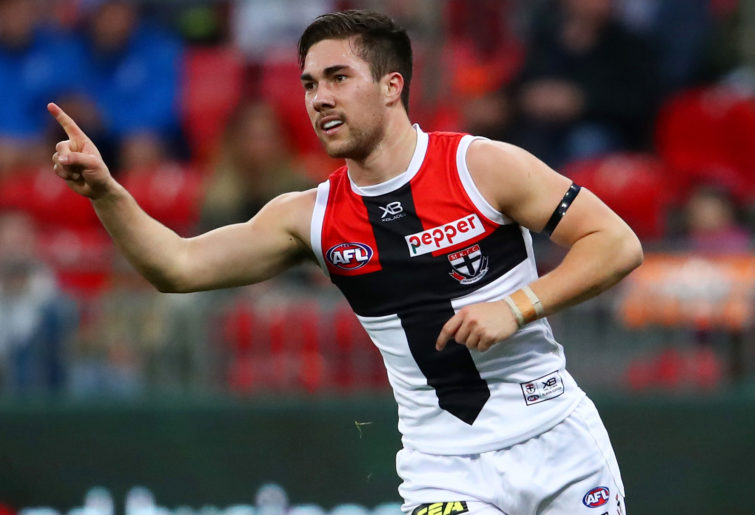
(Photo by Cameron Spencer/Getty Images)
But here’s my advice for St Kilda, and also 17 other clubs: win flags, not trades. Even if the deal has worked out well, the right course of action at that time should’ve been to invest the full value of that pick in the draft – even if that meant downgrading it into multiple picks so they could still target someone like Gresham, if he was their preference.
There’s a lot of Captain Hindsight action going in the above five paragraphs and I’m not going to pretend that if by some bizarre happenstance I was in charge of St Kilda’s list at the time I’d have been able to make any better decisions than what they did.
However they have to acknoweldge that the formative years which were supposed to be the key to making this rebuild a successful one have delivered a modest return at best, and the decisions they make now have to take that reality into consideration if they want to head in the direction of genuine success.
They’ve done well when it comes to drafting and trading over the last three years, but haven’t made a significant size of investment in the draft over that time. They need to have been matching the kind of effort Brisbane and Carlton have made to hit draft over the last few years, and haven’t come close.
The message coming out of St Kilda this year and last year and next year is that they expect to play finals. And while part of the reason for that is just saying the right thing at press conferences, it’s clear that this is a club who after eight years taking holidays in September, feel they have done their shift outside the spotlight.
If as expected they land Brad Hill, Zak Jones and Paddy Ryder, then even if they also lose Jack Steven (and perhaps Bruce, Carlisle and Acres), I believe there’s a genuine chance they play finals next year. I tip they’ll get a full season out of Dan Hannebery, who will make some haters look silly, and with a few other cards falling their way are every chance to sneak into the eight.
But ‘sneaking in’ feels like the ceiling for this team if they go down that route. I don’t believe they’d have enough genuine A-grade talent on the list to be a top-four or premiership threat, and the core of their strategy has to be making decisions based on that goal.
The Saints have tried to pursue talent of this type from other clubs in the form of Josh Kelly, Dylan Shiel and Stephen Coniglio over the last three years, but players of this calibre just don’t want to come to the club. That’s always likely to be the case for smaller Victorian teams.
That being the case, I can see why the opportunity to get a player like Brad Hill, given it comes up so rarely for this club, is appealing in the extreme. But, very good player that he is, I suspect not many would feel he can elevate them to the status of premiership contender.
Maybe there is a slim hope that the impact of Hill and company at the club could make them one of 2020’s most improved teams and just maybe generate enough positive momentum that an A-grader on the market next year feels they can be the player to put them over the top for a premiership. It’s a gamble of very long odds.
Probably the best argument I can make for trading in Hill is this: it’s a weak draft beyond the top-two this year anyway, so you’re not as likely to get a game-changer at pick 5 in 2019 as you were in a draft like last year’s, where players like Connor Rozee and Max King were on the table.
While now might not be the ‘right time’ to draft Hill, there’s no guarantee a player of his calibre will be on the market and willing to come to the club when that ‘right time’ arrives, and St Kilda not being a destination club means they’re less likely to get hooked on the trade drug than others.
It might well be the case that they can put the cart in front of the horse now and a few years down the track it will sort itself out – still, it’s not the philosophy I would personally pursue.

(Photo by Paul Kane/Getty Images)
Instead, my advice? Keep hitting the draft. It’s boring, it requires patience, it can be unlucky, and it certainly doesn’t sell memberships, but in my opinion, it’s the best chance for St Kilda to realise their premiership dream inside the next decade.
Especially for a team that is yet to confirm its permanent senior coach, they are simply not in a good position where it’s advisable to push all their chips into the middle of the table.
Give Brett Ratten or whoever else might land the role a year to work with and shape the playing list, then design a list management plan in concert with them at the end of 2020 – between now and then, just don’t do anything stupid.
Thanks to Stats Insider, the AFL Coaches Association, and Draftguru for providing data and tools to make the analysis in this article possible.






























































































